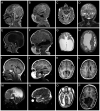Consistent chromosome abnormalities identify novel polymicrogyria loci in 1p36.3, 2p16.1-p23.1, 4q21.21-q22.1, 6q26-q27, and 21q2
- PMID: 18536050
- PMCID: PMC2801020
- DOI: 10.1002/ajmg.a.32293
Consistent chromosome abnormalities identify novel polymicrogyria loci in 1p36.3, 2p16.1-p23.1, 4q21.21-q22.1, 6q26-q27, and 21q2
Abstract
Polymicrogyria is a malformation of cortical development characterized by loss of the normal gyral pattern, which is replaced by many small and infolded gyri separated by shallow, partly fused sulci, and loss of middle cortical layers. The pathogenesis is unknown, yet emerging data supports the existence of several loci in the human genome. We report on the clinical and brain imaging features, and results of cytogenetic and molecular genetic studies in 29 patients with polymicrogyria associated with structural chromosome rearrangements. Our data map new polymicrogyria loci in chromosomes 1p36.3, 2p16.1-p23, 4q21.21-q22.1, 6q26-q27, and 21q21.3-q22.1, and possible loci in 1q44 and 18p as well. Most and possibly all of these loci demonstrate incomplete penetrance and variable expressivity. We anticipate that these data will serve as the basis for ongoing efforts to identify the causal genes located in these regions.
(c) 2008 Wiley-Liss, Inc.
Figures




References
-
- Ahlbom BE, Sidenvall R, Anneren G. Deletion of chromosome 21 in a girl with congenital hypothyroidism and mild mental retardation. Am J Med Genet. 1996;64:501–505. - PubMed
-
- Alanay Y, Aktas D, Utine E, Talim B, Onderoglu L, Caglar M, Tuncbilek E. Is Dandy-Walker malformation associated with “distal 13q deletion syndrome”? Findings in a fetus supporting previous observations. Am J Med Genet Part A. 2005;136A:265–268. - PubMed
-
- Aligianis IA, Johnson CA, Gissen P, Chen D, Hampshire D, Hoffmann K, Maina EN, Morgan NV, Tee L, Morton J, et al. Mutations of the catalytic subunit of RAB3GAP cause Warburg Micro syndrome. Nat Genet. 2005;37:221–223. - PubMed
-
- Alkan M, Ramelli GP, Hirsiger H, Keser I, Remonda L, Buhler EM, Moser H. Presumptive monosomy 21 with neuronal migration disorder re-diagnosed as de novo unbalanced translocation t(18p;21q) by fluorescence in situ hybridisation. Genet Couns. 2002;13(2):151–6. - PubMed
-
- Amor DJ, Leventer RJ, Hayllar S, Bankier A. Polymicrogyria associated with scalp and limb defects: variant of Adams-Oliver syndrome [In Process Citation] Am J Med Genet. 2000;93:328–334. - PubMed
Publication types
MeSH terms
Grants and funding
LinkOut - more resources
Full Text Sources
Medical
Research Materials

